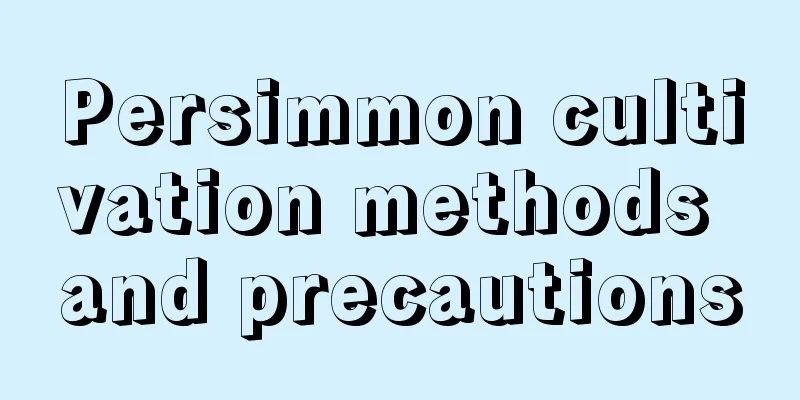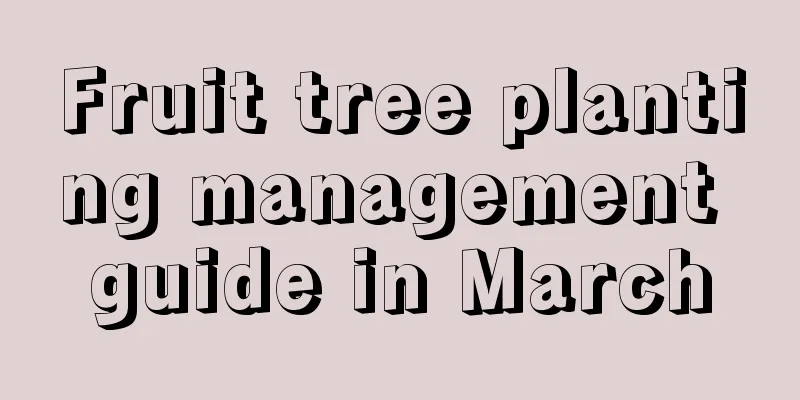Persimmon cultivation methods and precautions

1. Maintenance methods1. Temperature: The temperature suitable for its growth is between 9 degrees and 23 degrees. The temperature when the fruit is ripe should be maintained between 19 degrees and 23 degrees. Persimmons at this temperature are not easy to fall off or get diseased, which can increase the yield. 2. Watering: It is relatively drought-resistant. If the annual rainfall is above 500 ml, it does not need additional irrigation. If it is a potted plant, it is generally watered once a week. The amount of water each time does not need to be too much, just ensure that the soil is completely moist. 3. Fertilization: It can tolerate barrenness, but it does not mean that it does not need fertilizer. Generally, fertilizer is applied once every two weeks during the growing season, and no fertilizer is needed during the non-growing season. Fertilization is needed once before winter to ensure that it can safely survive the winter. 4. Light: It likes to live in an environment with plenty of sunlight. If it is a plant maintained indoors, it can receive sunlight all day without human intervention. If it is a plant grown indoors, it needs to be kept in a sunny place, and the daily light time should not be less than eight hours. 2. Breeding techniques1. Reproduction: The propagation of persimmon trees generally adopts the method of grafting. First, use black dates as the rootstock. After the collected fruits are softened, rub off the pulp and leave the seeds for later use. In November, soak the rootstock seeds for 24 hours, then mix them with wet sand and place them in a cool, sheltered place. You can then sow them in the spring of the following year. The sowing depth should be kept at about three centimeters. Cover the ground with plastic film after sowing. Thinning and transplanting should be carried out in time after the plants emerge. 2. Pruning: It generally does not require pruning. After harvesting the fruits, it is sufficient to do some proper pruning, mainly focusing on dry, rotten and fruit-bearing branches. 3. Problem Diagnosis1. Pests: It is more susceptible to infection by the persimmon cotton scale. If found, it is necessary to spray it with diesel emulsion before the plant sprouts in spring. This will eliminate overwintering pests. 2. Disease: Leaf drop in plants is most likely caused by lack of water, especially when encountering drought. Be sure to replenish water to the plants in time, and water them once a week will be enough. IV. Other issues1. Eat it: It is edible, but the elderly and children should not eat too much, otherwise it will cause indigestion. 2. Toxicity: non-toxic. |
<<: Breeding methods and precautions of Qingshengjin
>>: Cultivation methods and precautions of Toba Jade
Recommend
Cultivation methods and precautions of white flower Lycoris
1. Maintenance methods 1. Temperature: It prefers...
How to Plant Spinach Seeds
1. How to plant Select healthy and plump seeds an...
What to do if the leaves of green diamond flower turn yellow
1. Too much water If this is the reason why its l...
Is the flower of jasmine poisonous?
Is it poisonous? The flowers of the osmanthus tre...
Planting technology and cultivation management of Asparagus cochinchinensis
Asparagus cochinchinensis may be an unfamiliar na...
When is pineapple ripe?
January, April Its ripening time is divided into ...
How to prune daffodils
When to prune daffodils Daffodils are usually pru...
Does Guanyin Bamboo Bloom?
1. Whether it blooms Guanyin bamboo can bloom, an...
Don’t be afraid if the leaves turn yellow. Keep reading and I’ll teach you some tips to save your Mirabilis jalapa!
1. Fertilizer damage 1. Too much fertilizer Somet...
Can climbing roses be potted?
Can climbing roses be potted? Climbing roses can ...
How to sow periwinkle
Vinca roseus can be propagated by sowing Catharan...
Autumn and winter are dusty. 15 kinds of green plants are comparable to vacuum cleaners
Dripping Guanyin The leaves of the weeping angel ...
Is the yield of black peanuts high? What is the yield per mu?
Is the yield of black peanuts high? Black peanuts...
These flowers keep dying, they keep dying, I'm getting desperate...
Fuchsia 1. Water when the soil is dry. Wait until...
Is it suitable to grow tiger skin orchid indoors? What should I pay attention to when growing it indoors?
1. Is it suitable to keep it indoors? Tiger Piran...









